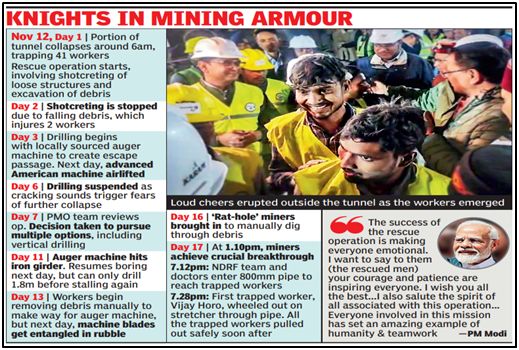Why in News?
- The multi-agency operation to rescue 41 workers trapped inside the Silkyara tunnel in Uttarkashi finally succeeded after days of ups and downs, when all of them were safely brought out.
- The massive effort, unprecedented in its magnitude and ambition, ended an ordeal that lasted 17 days and had the entire government machinery (including the PMO) putting its might behind the evacuation exercise.
What’s in Today’s Article?
- Timeline of Events at the Silkyara Tunnel Collapse
- Why the Rescue Took so Long - Understanding the Timeline
- Challenges Faced by the Rescue Teams
- Key Factors that Worked in Favour of Rescue Teams
Timeline of Events at the Silkyara Tunnel Collapse:

Why the Rescue Took so Long - Understanding the Timeline:
- Nov 12:
- 41 workers were trapped inside the Silkyara tunnel in Uttarkashi after a portion of the under-construction tunnel collapsed following a landslide.
- The rescue operation started immediately with basic supplies like oxygen, food, and water being given to them.
- Nov 13: Excavators had been removing debris to carve out a path to reach the workers.
- Nov 14:
- Excavators started drilling with the help of auger machinery to fix a wide steel pipe that would help pull out the trapped workers.
- A team of geologists from the state government and educational institutions had arrived to determine the cause of the accident.
- Nov 15: Falling debris hampers rescue efforts.
- Nov 16: A new drilling machine was installed after the National Highways & Infrastructure Development Corporation Limited (NHIDCL) was dissatisfied with the first one.
- Nov 17: Rescuers drill through 24 metres of debris. 4 mm pipes are inserted into the tunnel. However, the rescue efforts are hampered when one of the pipes hits an obstacle.
- Nov 18 and 19: Drilling remains suspended.
- Nov 20: Rescuers pushed through a new pipeline to the trapped workers. They had been relying on nuts, puffed rice, chickpeas and other dry food via a smaller pipe.
- Nov 21:
- Authorities released the first video of the 41 workers trapped inside the tunnel after a camera was sent into the tunnel through a new pipeline.
- Two explosions were carried out at the Balakot end of the tunnel. Workers were told to practise yoga and meditation for anxiety.
- Nov 22:
- Rescue teams drilled 32 metres of an estimated 60 metres that must be cleared to push through a pipe wide enough for the workers to crawl out.
- However, drilling was hampered after some iron rods came in the way of the auger machine.
- Nov 23: Drilling resumed and ambulances and medical support were kept on standby. Rescue operation entered the final stages.
- Nov 24: Rescue efforts were again hampered after the auger machine faced a hurdle, soon after the drilling resumed.
- Nov 25: Rescue teams were considering drilling through the last 10 metres of debris manually.
- Nov 26:
- Rescuers started drilling vertically from the top of the mountain where the workers were trapped.
- According to the National Disaster Management Authority (NDMA), 86 metres will have to be reached through vertical drilling to reach trapped workers.
- Nov 27: Rescuers brought in rat miners to drill through a narrow pipe by hand and help pull out the trapped workers.
- Nov 28: All 41 workers were rescued and were taken to hospital for treatment. Rescuers drilled through rocks and debris to finally reach the workers.
Challenges Faced by the Rescue Teams:
- A minor earthquake on November 16 caused the debris to shift 3 inches inside the tunnel.
- There was a possibility of the tunnel face collapsing, which could pose a significant setback to the entire operation.
- Most of the trapped workers recorded high BP which was attributed to anxiety, having been in such a situation for so long.
- The biggest setback was the breakdown of the auger machine used in drilling an escape passage through the debris.
Key Factors that Worked in Favour of Rescue Teams:
- It included access to electricity, water, and ample space for the trapped workers. Subsequently, when the supply line was established, the situation became more manageable.
- The "miracle" that everyone was looking for was realised by a group of workers known as "rat-hole" miners.
- They were brought in to manually dig through the last stretch of debris - around 12 meters after the auger machine parts were cleared from the escape passage.
- Once that was done (in less than 24 hours), rescue personnel were able to push inside 800mm pipes, welded together, which served as an escape tunnel through which the stranded workers eventually came out.









